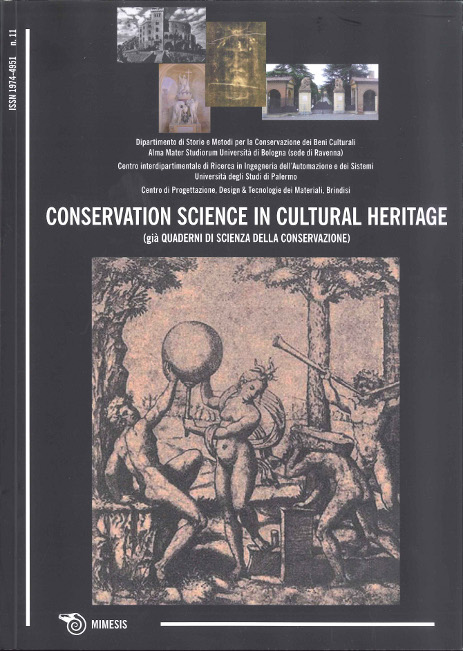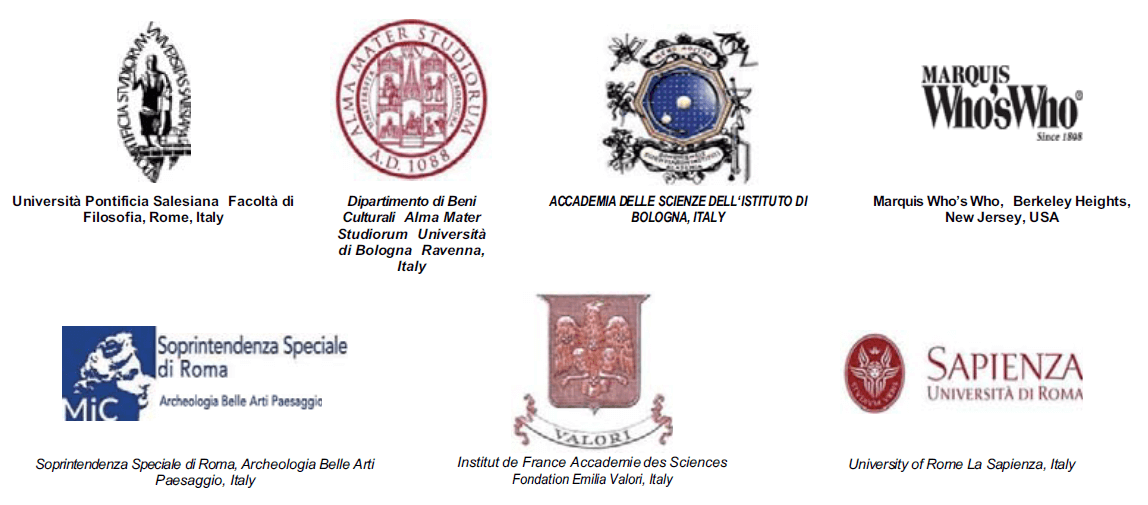Ancient and modern paper characterization by FTIR and Micro-Raman spectroscopy
DOI:
https://doi.org/10.6092/issn.1973-9494/2700Keywords:
cellulose structure and degradation, acid substance, oxidative agentsAbstract
Archive and library materials are an important part of our national cultural heritage. In order to identify appropriate methods for the conservation and restoration of such materials, it is important to establish the current physical-chemical state of the artifact and how it can be influenced by the chemical reactions it meets with. The degree of crystallinity and orientation of the paper fibers has a significant influence on its mechanical properties. Many chemical and physical reactions can increase amorphous areas and susceptibility to biological attack, thus making the paper more brittle.
Spectroscopy is one of the most powerful tools for the characterization of paper materials and for the identification of degradation products. This paper describes the application of FTIR and Micro-Raman spectroscopy for the characterization of cellulosic materials.
Riassunto
I materiali di archivio e di biblioteca sono una parte importante del nostro patrimonio culturale nazionale. Al fine di individuare metodi adeguati di conservazione e restauro di tali materiali, è importante capire l'attuale stato fisico-chimico del manufatto e come questo può essere influenzato dalle reazioni chimiche che si verificano su di essi. Il grado di cristallinità e l'orientamento delle fibre di carta ha una notevole influenza sulle sue proprietà meccaniche. Molte sostanze chimiche e reazioni fisiche possono aumentare le zone amorfe e la suscettibilità agli attacchi biologici, rendendo la carta più fragile.
La spettroscopia è uno dei più potenti strumenti per la caratterizzazione dei materiali costituenti la carta e per l'identificazione dei prodotti di degradazione. Questo articolo descrive l'applicazione della spettroscopia FTIR e micro-Raman per la caratterizzazione dei materiali cellulosici.
Résumé
Les matériels d’archives et de bibliothèque sont une partie importante de notre patrimoine culturel national. Afin de déterminer les méthodes adéquates de conservation et restauration de ces matériels, il est important de comprendre l’actuel état physico-chimique du produit manufacturé et comment celui-ci peut être influencé par les réactions chimiques qui se vérifient sur eux. Le grade de cristallinité et l'orientation des fibres de papier a une remarquable influence sur ses propriétés mécaniques. De nombreuses substances chimiques et de réactions physiques peuvent augmenter les zones amorphes et la susceptibilité aux attaques biologiques, rendant le papier plus fragile.
La spectroscopie est un des plus puissants instruments pour la caractérisation des matériaux constituant le papier et pour l'identification des produits de dégradation. Cet article décrit l'application de la spectroscopie FTIR et micro-Raman pour la caractérisation des matériaux cellulosiques.
Zusammenfassung
Die Archiv- und Bibliotheksmaterialien bilden einen wichtigen Bestandteil unseres nationalen Kulturerbes. Um geeignete Konservierungs- und Restaurierungsverfahren für diese Materialien zu finden, ist es wichtig, den gegenwärtigen physikalisch-chemischen Zustand des Gegenstands zu verstehen und wie dieser durch chemische Reaktionen, die an ihm eintreten, beeinflusst werden kann. Der Kristallisationsgrad und die Ausrichtung der Papierfasern haben einen beträchtlichen Einfluss auf die mechanischen Eigenschaften. Viele chemische Substanzen und physikalische Reaktionen können die amorphen Zonen vergrößern und die Anfälligkeit für biologische Angriffe erhöhen und damit das Papier brüchiger machen.
Die Spektroskopie ist eines der mächtigsten Instrumente zur Charakterisierung der Materialien, aus denen das Papier besteht, und zur Identifizierung der Zersetzungsprodukte. Dieser Artikel beschreibt die Anwendung der FTIR-/Raman-Mikrospektroskopie zur Charakterisierung von Zellulosematerialien.
Resumen
Los materiales de archivo y de biblioteca son una parte importante de nuestro patrimonio cultural nacional. A fin de definir métodos adecuados de conservación y restauración de dichos materiales, es importante entender el actual estado físico-químico de la pieza, y como puede verse influenciado por las reacciones químicas que se producen en ellas. El grado de cristalinidad y la orientación de las fibras de papel tienen una notable influencia en sus propiedades mecánicas. Muchas sustancias químicas y reacciones físicas pueden aumentar las zonas amorfas y la susceptibilidad a los ataques biológicos, haciendo más frágil el papel.
La espectroscopia es uno de los más potentes instrumentos para la caracterización de los materiales que componen el papel y para identificar los productos de degradación. Este artículo describe la aplicación de la espectroscopia FTRIR y micro-Raman para la caracterización de los materiales celulósicos.
Резюме
Материалы архива и библиотеки являются важной составляющей частью нашего национального культурного наследия. С целью определения адекватных методов для сохранения и реставрации данных материалов важно понять настоящее физико-химическое состояние артефакта и как его могут изменить химимческие реакции, влияющие на него. Степень кристалличности и ориентация волокон бумаги определяют ее механические свойства.
Многие химические вещества и физические реакции могут увеличить аморфные зоны и восприимчивость к биологическим атакам, делая бумагу более хрупкой. Спектроскопия – один из наиболее мощных инструментов для определения характеристик материалов, составляющих бумагу и определения продуктов ее деградации. Данная статья описывает применение спектроскопии FTIR и микро-Раман для характеристики целлюлозного материала.
References
ERHARDT D., TUMOSA C.S 2005, Chemical Degradation of Cellulose in Paper over 500 Years, Restaurator 26, 151–158, http://www.reference-global.com/doi/
abs/10.1515/rest.2005.26.3.151.
COPEDÈ M. 2003, La Carta e il suo Degrado, IV ed., Cardini Ed., Firenze.
ZAPPALÀ A. 2004, Reflections on the Conservation and the Conservative Restoration of Archive and Library Materials, Conservation Science in Cultural Heritage – Quaderni di scienza della conservazione, 4, 195 – 207, http://conservation-science.unibo.it/article/view/577/558.
FENGEL D., WEGENER G. 1989, Wood Chemistry, Ultrastructure, Reaction, Walter de Gruyter, Berlin.
BROWING B.L. 1977, Analysis of Paper, Marcell-Dekker, New York.
LORUSSO S., NATALI A. 2005, Air Quality in Bounded Environments, Conservation Science in Cultural Heritage – Quaderni di scienza della conservazione,4, 215 – 238, http://conservation-science.unibo.it/article/view/579/560.
GILBERT C., KOKOT S., MEYER U. 1993, Application of DRIFT Spectroscopy and Chemometrics for the Comparison of Cotton Fabrics, Applied Spectroscopy, 47, 741-748.
LIU Y. KOKOT S. SAMBI, T.J. 1998, Vibrational Spectroscopy Investigation of Australian Cotton Cellulose Fibres, Part 2. A Fourier transform near-infrared preliminary study, Analyst 123, 1725-1728, http://elibrary.ru/item.asp?id=936988.
VASCO P.D., BLACKWELL J., KOENIG J.L 1972, Infrared and Raman Spectroscopy of Carbohydrates, Part II: normal coordinate analysis of glucose, Carbohydr. Res., 23, 407-416.
LIN-VIEN D., COLTHUP N.B., FATELY W.G., GRASELLI J.G. 1991, The Handbook of Infrared and Raman Characteristic Frequencies of Organic Molecules, Academic Press, San Diego, CA.
ZHBANKOV R.G., ADRIANOW W.M., RATAJCZAK H., MARCHEWKA M., Vibrational Spectra (IR and Raman) and Stereoisomers of Carbohydrates Zh. Fiz. Khim, 69 (1995) 553-558 (in Russian). Russ. J. Phys. Chem., 68 (1995) (English translation).
ZHBANKOV R.G., ADRIANOW W.M., RATAJCZAK H., MARCHEWKA M., Zh. Struktur. Chem. Vibrational Spectra and Stereochemistry of Mono- and Polysaccharides, I, Anomers of D-Glucose, Zh. Strukt. Khim., 36 (1995) 322-329 (in Russian). J. Struct. Chem., 36 (1995) 287-294 (English translation).
WILEY J.H., ATALLA R.H. 1985, Carbohydr. In: R.H. Atalla, Editor, The Structure of Cellulose ACS Symposium Series 340, p. 151 Chicago.
TU A.T., LEE J., MILANOVICH F.P. 1979, Laser-Raman Spectroscopic Study of Cyclohexaamylose and Related Compounds; Spectral Analysis and Structural Implications, Carbohydr, Res. 76, 239-244.
Downloads
Published
How to Cite
Issue
Section
License
Copyright (c) 2011 Vito Librando, Zelica Minniti, Salvatore Lorusso
Copyrights and publishing rights of all the texts on this journal belong to the respective authors without restrictions. Authors grant the journal right of first publication.
This journal is licensed under a Creative Commons Attribution 4.0 International License (full legal code).
See also our Open Access Policy.






